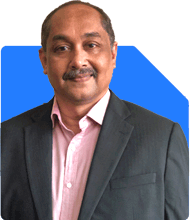Samraat Jadhav |2498 Answers |Ask -Follow
Stock Market Expert - Answered on Jul 24, 2023
He is a SEBI-registered investment and research analyst and has over 18 years of experience in managing high-end portfolios.
A management graduate from XLRI-Jamshedpur, Jadhav specialises in portfolio management, investment banking, financial planning, derivatives, equities and capital markets.... more

What is target of HDFC BANK Share before September 2023 ?
Disclaimer: Investments in securities are subject to market RISKS. Read all the related documents carefully before investing. Please consult your appointed/paid financial adviser before taking any decision. The securities quoted are for illustration only and are not recommendatory. Registration granted by SEBI, membership of BASL and certification from NISM in no way guarantee performance of the intermediary or provide any assurance of returns to investors.
You may like to see similar questions and answers below
Ambareesh Baliga | Answer |Ask -Follow
Stock Market Expert - Answered on Feb 05, 2023
Samraat Jadhav |2498 Answers |Ask -Follow
Stock Market Expert - Answered on Jul 03, 2023
Advait Arora | Answer |Ask -Follow
Financial Planner - Answered on Aug 07, 2023
Samraat Jadhav |2498 Answers |Ask -Follow
Stock Market Expert - Answered on Oct 14, 2024
Dr Dipankar Dutta |1837 Answers |Ask -Follow
Tech Careers and Skill Development Expert - Answered on Dec 05, 2025
Dr Shyam Jamalabad |108 Answers |Ask -Follow
Dentist - Answered on Dec 05, 2025
Dr Shyam Jamalabad |108 Answers |Ask -Follow
Dentist - Answered on Dec 05, 2025
Dr Shyam Jamalabad |108 Answers |Ask -Follow
Dentist - Answered on Dec 05, 2025
Dr Dipankar Dutta |1837 Answers |Ask -Follow
Tech Careers and Skill Development Expert - Answered on Dec 05, 2025
Ulhas Joshi |280 Answers |Ask -Follow
Mutual Fund Expert - Answered on Dec 05, 2025
Dr Dipankar Dutta |1837 Answers |Ask -Follow
Tech Careers and Skill Development Expert - Answered on Dec 04, 2025
Ravi Mittal |676 Answers |Ask -Follow
Dating, Relationships Expert - Answered on Dec 04, 2025
Anu Krishna |1745 Answers |Ask -Follow
Relationships Expert, Mind Coach - Answered on Dec 04, 2025
Anu Krishna |1745 Answers |Ask -Follow
Relationships Expert, Mind Coach - Answered on Dec 04, 2025




























